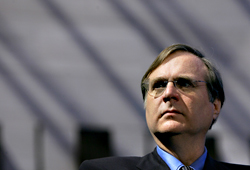One of the world’s richest men has become one of the neediest. Paul Allen’s St. Louis cable company is $20 billion in the hole—equal almost to his personal worth—and he’s hinting at bankruptcy again for another of his corporations, the Portland Trail Blazers. No matter that he is a Texas oilman who captains the world’s biggest yacht and fields a Super Bowl football team, Allen may end up asking forgiveness from debtors and for more manna from taxpayers. Of course, this is how the rich stay rich. That, and selling a little insurance on the side.
Besides recently taking a 54 percent interest in Plains All America Pipeline, a Houston petroleum company with 15,000 miles of pipe, the ever-diversifying Microsoft co-founder has also bought Colorado-based International Catastrophe Insurance Managers, which specializes in coverage for small businesses in U.S. tornado- hurricane regions.
They are eclectic additions to the 50-company portfolio Allen has amassed, and they illustrate his investment shift from a “wired world” development strategy to less-exotic, segregated properties. But catastrophe insurance? Is the shy billionaire trying to tell us something?
His broadband cable company, Charter Communications, is carrying massive debt, and its market value is a pittance of the $7 billion Allen paid for it and another cable firm eight years ago. Charter’s share price this week was around $1. “Any other company in Charter’s condition,” says The Wall Street Journal, “would probably seek bankruptcy protection.”
Well, “It is true that Charter has around $20 billion of debt,” confirms Michael Nank, spokesperson for Allen’s Seattle-based Vulcan parent company. “But the bank debt and bonds are obligations of the company [Charter]. They are not financial obligations of Paul or Vulcan. Those securities are held by various institutions such as hedge funds and certain fund managers.”
So Allen, Mercer Island’s wealthiest human—and the world’s sixth-richest—doesn’t default on his obligations because he’s running out of money. He defaults as a strategy—S.O.P. for corporate America. The corporations under his wing are set up as stand-alone entities, of course, with each company responsible for its own debts, even if it sends any profits up the line to Allen’s Seattle headquarters. In Portland, for example, his basketball arena company declared bankruptcy to get out of a bad public deal at the Rose Garden. He also claims his money-losing Trail Blazers professional basketball team has, in words identical to those being used by Howard Schultz, principal owner of the arena-hunting Seattle SuperSonics, a “broken economic model” that can be fixed only with more taxpayer aid. Failing that, Allen may declare Chapter 11 bankruptcy to reorganize—or perhaps to slip his lease with taxpayers and move the team. He’s sorry, but it’s just business.
Taxpayers in Seattle know him primarily as the owner of the Seahawks and the mayor of Allentown—office buildings, condos, museum, theater, and a football stadium arrayed in a swath of properties stretching from SLU to SoDo. His Seattle land ownership is second only to local and state government, from which he has wrung more than $1 billion in taxpayer aid over the years, mainly through a 1997 football-stadium deal.
He utilized public land to build his ever-struggling museum, the Experience Music Project at Seattle Center. Allen probably holds the record for taxpayer largesse, paying just $161 million to build Qwest Field, which is the $900 million (with interest) public stadium he operates. His extensive South Lake Union condo-office developments are expected to directly benefit from an estimated $500 million the city will spend for necessary new utilities and transportation improvements.
His other private investments include The Sporting News, which failed to pay off and is for sale. Most of his interests are overseen by the mother ship, Vulcan. Though primarily a businessman, on his Web site, PaulAllen.com, he is referred to as “collector and philanthropist.” His Paul G. Allen Foundation doled out $800 million, and he has quietly gathered up one of the more impressive art collections. Currently, at EMP, he is exhibiting master and modern canvases by Monet, Degas, and Jasper Johns, juxtaposed with Jimi Hendrix’s Gibson guitar (see “Seeing ‘Double,'” April 12).
Allen is also developing a palm-sized PC with integrated phone and camera and has launched a research project to develop what he calls the “Digital Aristotle,” an electronic concept for tutoring and researching scientific discoveries. In his spare time, he maps the brain at the Allen Institute for Brain Science in Fremont.
He’s also lost more money than God. In 2003, a fortune that had once topped $30 billion had “dwindled” by about $12 billion, estimated BusinessWeek. He sold off most of an original 28 percent stake in Microsoft stock. That might be the most tantalizing aspect of Allen’s wheeling- dealing. If he’d hung on to all his Microsoft shares, foregone most of his investments, and just lazed about on one of his yachts, his fortune would top $80 billion today.








